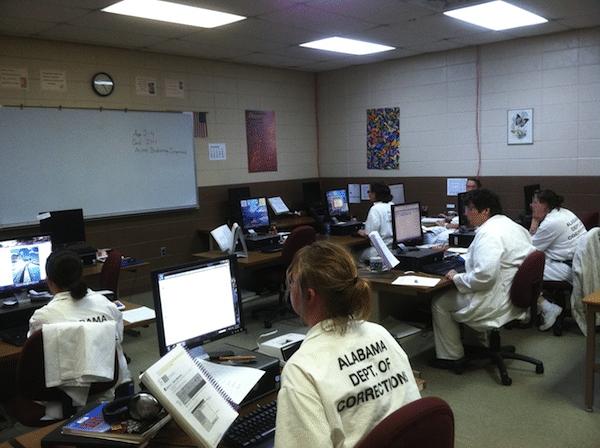Life After Prison: Interview With Robin, Student And Tutwiler Inmate
Students in an office information systems class at J.F. Ingram State Technical College's Tutwiler prison campus. Technically this is school property, but the building is inside the security perimeter. From the outside it's indistinguishable from the rest of the prison, but inside, the atmosphere of what the inmates call "the trade school" is more hopeful.
 Wetumpka, Ala. — All this week, WBHM explores challenges people face after being released from Alabama’s prisons. One barrier is a lack of skills. But some educators are working to smooth that transition long before the inmates get out: J.F. Ingram State Technical College has a new program at Tutwiler Prison that teaches vocations and life skills, including getting along with others, with the goal of reducing recidivism.
Wetumpka, Ala. — All this week, WBHM explores challenges people face after being released from Alabama’s prisons. One barrier is a lack of skills. But some educators are working to smooth that transition long before the inmates get out: J.F. Ingram State Technical College has a new program at Tutwiler Prison that teaches vocations and life skills, including getting along with others, with the goal of reducing recidivism.
WBHM’s Dan Carsen sat in on those classes, the subject of this 25-minute radio documentary. He later caught up with a student — an inmate named Robin. We agreed not to use last names, but Dan asked her about her plans once she’s out and about why she’s in prison:
Listen to WBHM’s Life After Prison Series:
Part One – Ex-offenders Face Many Challenges When Reentering Society
Part Two – Interview With Robin, Life-Skills Student And Tutwiler Prison Inmate
Part Three – Ex-felons Often Struggle to Find a Job
Part Four – How Prison Shaped a Woman’s Career Path
Part Five – Victims Face Tough Road Too
Birmingham is 3rd worst in the Southeast for ozone pollution, new report says
The American Lung Association's "State of the Air" report shows some metro areas in the Gulf States continue to have poor air quality.
Why haven’t Kansas and Alabama — among other holdouts — expanded access to Medicaid?
Only 10 states have not joined the federal program that expands Medicaid to people who are still in the "coverage gap" for health care
Once praised, settlement to help sickened BP oil spill workers leaves most with nearly nothing
Thousands of ordinary people who helped clean up after the 2010 BP oil spill in the Gulf of Mexico say they got sick. A court settlement was supposed to help compensate them, but it hasn’t turned out as expected.
Q&A: How harm reduction can help mitigate the opioid crisis
Maia Szalavitz discusses harm reduction's effectiveness against drug addiction, how punitive policies can hurt people who need pain medication and more.
The Gulf States Newsroom is hiring a Community Engagement Producer
The Gulf States Newsroom is seeking a curious, creative and collaborative professional to work with our regional team to build up engaged journalism efforts.
Gambling bills face uncertain future in the Alabama legislature
This year looked to be different for lottery and gambling legislation, which has fallen short for years in the Alabama legislature. But this week, with only a handful of meeting days left, competing House and Senate proposals were sent to a conference committee to work out differences.








